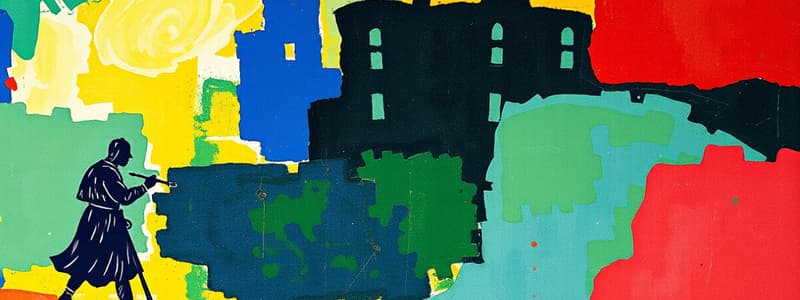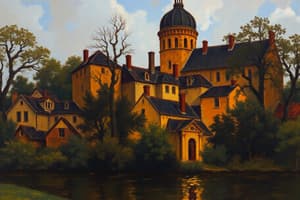Podcast
Questions and Answers
The historical period from about AD 500 to about AD 1500 is referred to as the Medieval period or the ___________ __________.
The historical period from about AD 500 to about AD 1500 is referred to as the Medieval period or the ___________ __________.
Middle Ages
A building where monks or nuns live and work in community is a ___________.
A building where monks or nuns live and work in community is a ___________.
monastery
Saint Francis of Assisi formed a religious community of __________ who begged for what they needed to live.
Saint Francis of Assisi formed a religious community of __________ who begged for what they needed to live.
Friars
Saint Thomas Aquinas, an important figure in the __________ __________, emphasized arriving at the truth through dialogue with different points of view.
Saint Thomas Aquinas, an important figure in the __________ __________, emphasized arriving at the truth through dialogue with different points of view.
A major break that causes division is a __________.
A major break that causes division is a __________.
What is the difference between Friars and Monks?
What is the difference between Friars and Monks?
How many times was Benedict almost killed?
How many times was Benedict almost killed?
Where did the Rosary come from?
Where did the Rosary come from?
What were the two groups of the Church?
What were the two groups of the Church?
What was one of Jesus' teachings?
What was one of Jesus' teachings?
What is Monasticism?
What is Monasticism?
Who was Benedict?
Who was Benedict?
What does 'Work and pray' refer to?
What does 'Work and pray' refer to?
Who was St. Bernardo of Clairvaux?
Who was St. Bernardo of Clairvaux?
What did Nuns and Monks do?
What did Nuns and Monks do?
What are Guilds?
What are Guilds?
Who was the Western empire invaded by?
Who was the Western empire invaded by?
What was the Scholastic movement?
What was the Scholastic movement?
Who was Saint Thomas Aquinas?
Who was Saint Thomas Aquinas?
What does 'Truth cannot contradict truth, faith cannot contradict faith' mean?
What does 'Truth cannot contradict truth, faith cannot contradict faith' mean?
What are stained glass windows?
What are stained glass windows?
Who were Angela Merici and the Ursulines?
Who were Angela Merici and the Ursulines?
What is the Carolingian Renaissance?
What is the Carolingian Renaissance?
_______ can also refer to events, people, traditions, or anything else from the Middle Ages, whether it's religious, political, artistic, or educational.
_______ can also refer to events, people, traditions, or anything else from the Middle Ages, whether it's religious, political, artistic, or educational.
Later in the Middle Ages, a few holy monks and nuns __________ existing monasteries to help focus on prayer.
Later in the Middle Ages, a few holy monks and nuns __________ existing monasteries to help focus on prayer.
Who was Pope Urban II?
Who was Pope Urban II?
In the year 800, the Pope __________ recognized Charlemagne's importance to Christendom by crowning him as the Holy Roman Emperor.
In the year 800, the Pope __________ recognized Charlemagne's importance to Christendom by crowning him as the Holy Roman Emperor.
A movement known as the _________ Renaissance brought new advances in art, writing, architecture, and literacy.
A movement known as the _________ Renaissance brought new advances in art, writing, architecture, and literacy.
What was the only successful crusade?
What was the only successful crusade?
Who was the Children's Crusade led by?
Who was the Children's Crusade led by?
In this case, the _________ was ultimately caused by a refusal to submit to the pope's _________.
In this case, the _________ was ultimately caused by a refusal to submit to the pope's _________.
Up until ________, the _________ Church had still accepted the authority of the _________ as the successor of Saint Peter.
Up until ________, the _________ Church had still accepted the authority of the _________ as the successor of Saint Peter.
In the __________, both leaders _________ each other.
In the __________, both leaders _________ each other.
What does Excommunication mean?
What does Excommunication mean?
Yet hope for ________ still springs up: In _______, Saint John Paul II and _________ Bartholomew I of __________ celebrated the _________ together!
Yet hope for ________ still springs up: In _______, Saint John Paul II and _________ Bartholomew I of __________ celebrated the _________ together!
Muslims conquered areas previously controlled by _________.
Muslims conquered areas previously controlled by _________.
Through their contact with ________ scholars, the Crusaders also brought back advances in astronomy, mathematics, and science to Europe.
Through their contact with ________ scholars, the Crusaders also brought back advances in astronomy, mathematics, and science to Europe.
If a ________ had been committed, the defendant was given a Church punishment - such as fasting, making a pilgrimage, attending Mass more frequently, or wearing a distinctive piece of clothing.
If a ________ had been committed, the defendant was given a Church punishment - such as fasting, making a pilgrimage, attending Mass more frequently, or wearing a distinctive piece of clothing.
What was the Spanish Inquisition?
What was the Spanish Inquisition?
These issues included ______, which is the purpose of buying and selling Church roles or spiritual privileges; priests having wives, either publicly or secretly, and lay investiture.
These issues included ______, which is the purpose of buying and selling Church roles or spiritual privileges; priests having wives, either publicly or secretly, and lay investiture.
What is Investiture?
What is Investiture?
St.________ of Siena was a _______, meaning that she had a very intense, _______ experiences of God's presence.
St.________ of Siena was a _______, meaning that she had a very intense, _______ experiences of God's presence.
When did the Bubonic Plague reach Europe?
When did the Bubonic Plague reach Europe?
Unlike monks, however, _____ move around in order to ______ and teach, instead of staying in one _________.
Unlike monks, however, _____ move around in order to ______ and teach, instead of staying in one _________.
Who was Pope Benedict?
Who was Pope Benedict?
What is the Era of Christendom?
What is the Era of Christendom?
What are the two aspects of the Church?
What are the two aspects of the Church?
Leo III- crowned Charlemagne as emperor of the Romans.
Leo III- crowned Charlemagne as emperor of the Romans.
Who was Urban II?
Who was Urban II?
What do Callistus II & Henry VI represent?
What do Callistus II & Henry VI represent?
What is Investiture?
What is Investiture?
Nero is known for his __________.
Nero is known for his __________.
Why was the Council of Nicaea called?
Why was the Council of Nicaea called?
What is the Holy Spirit?
What is the Holy Spirit?
What did the Council of Ephesus declare?
What did the Council of Ephesus declare?
What does God do?
What does God do?
What was the first Ecumenical Council?
What was the first Ecumenical Council?
What were some of the rules in the Eastern Church?
What were some of the rules in the Eastern Church?
What was the main goal of the Crusades?
What was the main goal of the Crusades?
What did the Crusades do that Jesus didn't want them to do?
What did the Crusades do that Jesus didn't want them to do?
What was the Council of Chalcedon about?
What was the Council of Chalcedon about?
Who was St. Jerome?
Who was St. Jerome?
What was the Council of Nicaea about?
What was the Council of Nicaea about?
Who was St. Catherine of Siena?
Who was St. Catherine of Siena?
Who was St. John Chrysostom, Archbishop of Constantinople?
Who was St. John Chrysostom, Archbishop of Constantinople?
Who was St. Augustine, Bishop of Hippo?
Who was St. Augustine, Bishop of Hippo?
What was the significance of the 4th and 5th centuries?
What was the significance of the 4th and 5th centuries?
What is an apologist?
What is an apologist?
What happened to the Church?
What happened to the Church?
What are icons?
What are icons?
What was a 'Lay investiture'?
What was a 'Lay investiture'?
What did the Eastern Empire want/need?
What did the Eastern Empire want/need?
Who was St. Francis?
Who was St. Francis?
What was the Council of Ephesus?
What was the Council of Ephesus?
What was the first inquisition?
What was the first inquisition?
What was the second inquisition?
What was the second inquisition?
When was the Edict of Milan issued?
When was the Edict of Milan issued?
Who was Saint Teresa of Avila?
Who was Saint Teresa of Avila?
What are the three evangelical councils?
What are the three evangelical councils?
What year did the Roman Empire collapse?
What year did the Roman Empire collapse?
Why were the crusaders called the holy wars?
Why were the crusaders called the holy wars?
What did Saint Basil do to make an impact in the South?
What did Saint Basil do to make an impact in the South?
What symbol did Constantinople put on their shields?
What symbol did Constantinople put on their shields?
What made Christianity legal?
What made Christianity legal?
Who was described as a monster in revelation?
Who was described as a monster in revelation?
What are the Catacombs?
What are the Catacombs?
When did the Black Death/Barbaric Plague rise?
When did the Black Death/Barbaric Plague rise?
What are the Fathers of the Church (Church Fathers)?
What are the Fathers of the Church (Church Fathers)?
Flashcards are hidden until you start studying
Study Notes
Medieval Period and Church Structure
- The Medieval period, also known as the Middle Ages, spanned from approximately AD 500 to AD 1500.
- A monastery is a community where monks or nuns live and work together.
- Friars, established by Saint Francis of Assisi, travel and beg for their living needs unlike monks who remain in monasteries.
Key Religious Figures and Movements
- Saint Thomas Aquinas was significant in the Scholastic movement, promoting truth through dialogue and reasoning.
- Pope Urban II instigated the First Crusade in 1095, calling Christians to reclaim the Holy Land from Muslims.
- Saint Jerome translated the Bible into Latin (Vulgate), making it more accessible.
Events and Concepts
- A schism refers to a significant division or break, particularly within the Church.
- Monasticism embodies a spiritual lifestyle focused on contemplation and community.
- The Carolingian Renaissance was marked by advancements in art, writing, architecture, and literacy initiated by Charlemagne.
The Crusades
- The First Crusade was the only successful expedition, aimed to retake Jerusalem.
- The Children’s Crusade was led by Stephen of Cloyes and involved young participants.
- Crusaders encountered Muslim scholars, facilitating the return of advancements in various sciences to Europe.
Church Authority and Conflict
- The schism of 1054 resulted from a refusal to submit to papal authority, leading to mutual excommunication between church leaders.
- The Spanish Inquisition targeted converted Jews and Muslims to ensure sincerity of faith.
Theological Developments
- The Council of Nicaea addressed Arianism, declaring the full divinity of Christ, leading to the Nicene Creed.
- The Council of Chalcedon affirmed the hypostatic union of Christ’s two natures—human and divine.
Social and Cultural Impact
- Guilds were associations of merchants or artisans aimed at protecting economic interests and passing on trades.
- The Black Death, peaking in 1347, had devastating impacts on Europe, affecting social and religious structures.
Exploration of Faith
- Icons are holy images used in veneration but can be viewed as idolatry.
- Apologists defend the faith against criticisms and misconceptions.
- St. Augustine and St. John Chrysostom significantly shaped Christian thought and pastoral practices.
Final Notes
- The period saw complex tensions between spiritual and physical realities within the Church, as exemplified by lay investiture scandals and internal advancements in monastic reforms.
- The Edict of Milan in 313 legalized Christianity, transforming its status within the Roman Empire.
Studying That Suits You
Use AI to generate personalized quizzes and flashcards to suit your learning preferences.



